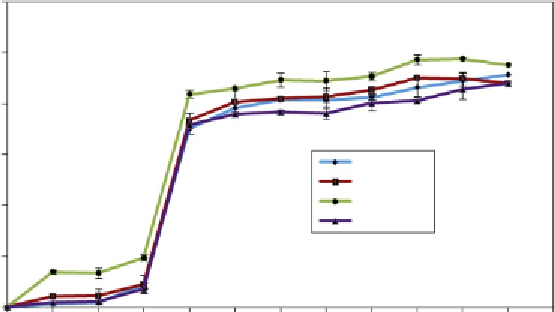Biology Reference
In-Depth Information
120
100
80
60
Agria
Moonlight
Nadine
Red Rascal
40
20
0
G0
G15
G30
I0
I5
I10
I15
I20
I30
I60
I90
I120
I140
Time (min)
Figure 4.6 Starch hydrolysis (%) of cooked potatoes from different cultivars during sim-
ulated gastric (for 30 min) followed by small intestinal (for 2 h) digestion. Reproduced
from
Bordoloi, Singh, et al. (2012)
with permission from Elsevier.
simulated intestinal fluid (SIF, pH 6.8) was added to the reaction mixture,
the starch was rapidly digested by the pancreatic amylases. Approximately,
70% of the starch in cooked potatoes was digested within first 10 min of sim-
ulated small intestinal digestion. The starch hydrolysis level ranged between
80% and 95% for different cultivars at the end of small intestinal digestion.
However, this percentage may not be interpreted as the percentage of
hydrolysis of cooked potatoes
in vivo
as the latter is much more complex.
The observed difference among the starch hydrolysis of cooked potato
cultivars could be attributed to the interplay of many factors, such as starch
characteristics, microstructure of food, susceptibility of starch toward hydro-
lysis, extent of starch gelatinization, and molecular association between starch
simulated small intestinal conditions, the starch in cooked potatoes was hydro-
lyzed in a similar manner to that of pure starch as observed in previous studies
(
Dartois et al., 2010
)
. However, the starch hydrolysis (%) values in cooked
potatoes were slightly lower than pure starch throughout the small intestinal
digestion
in vitro
. The lower levels of hydrolysis could be attributed to the
presence of cell wall and other components in the potatoes as reported in
the earlier studies (
Singh et al., 2010
)
. Other components present in food
matrix, such as cell wall materials, dietary fiber, polysaccharides, proteins,


